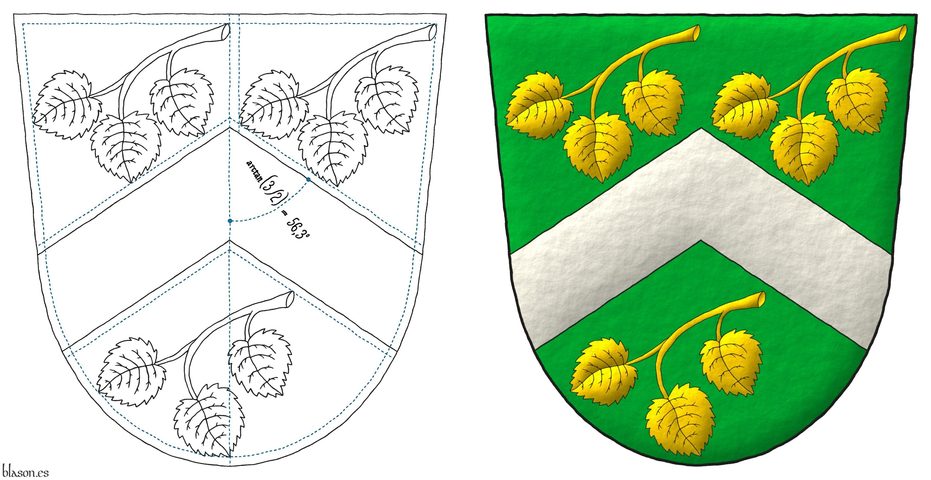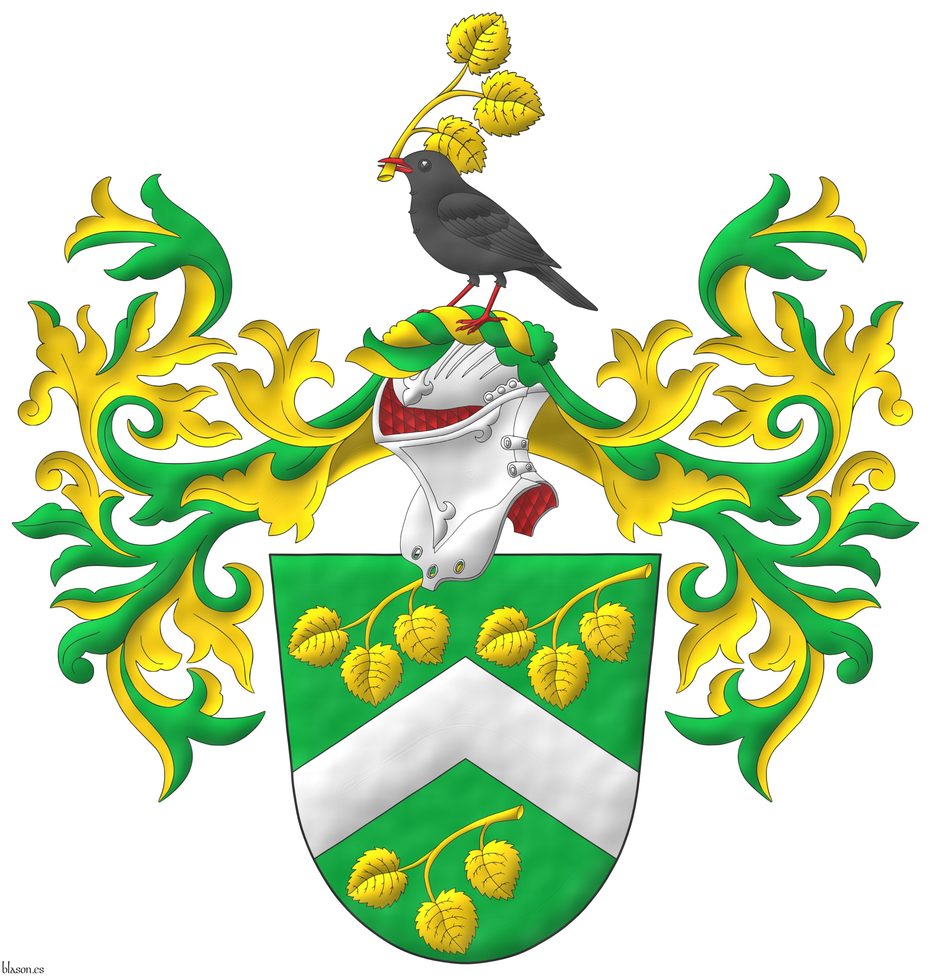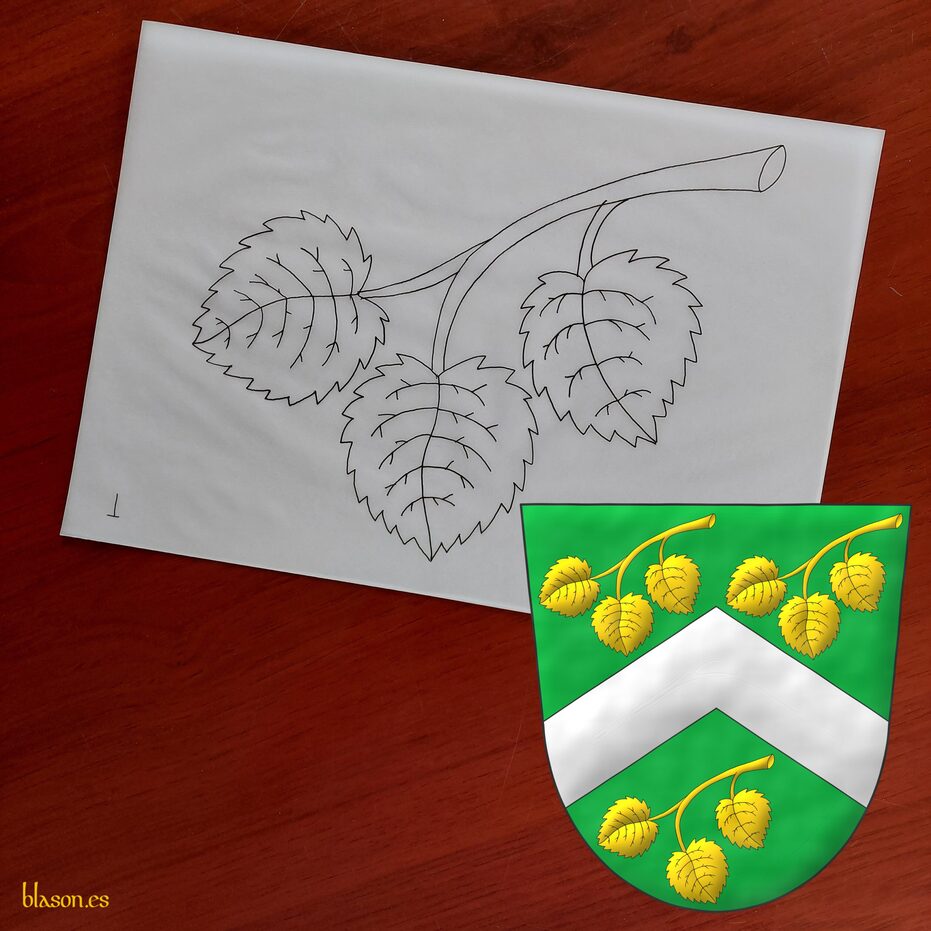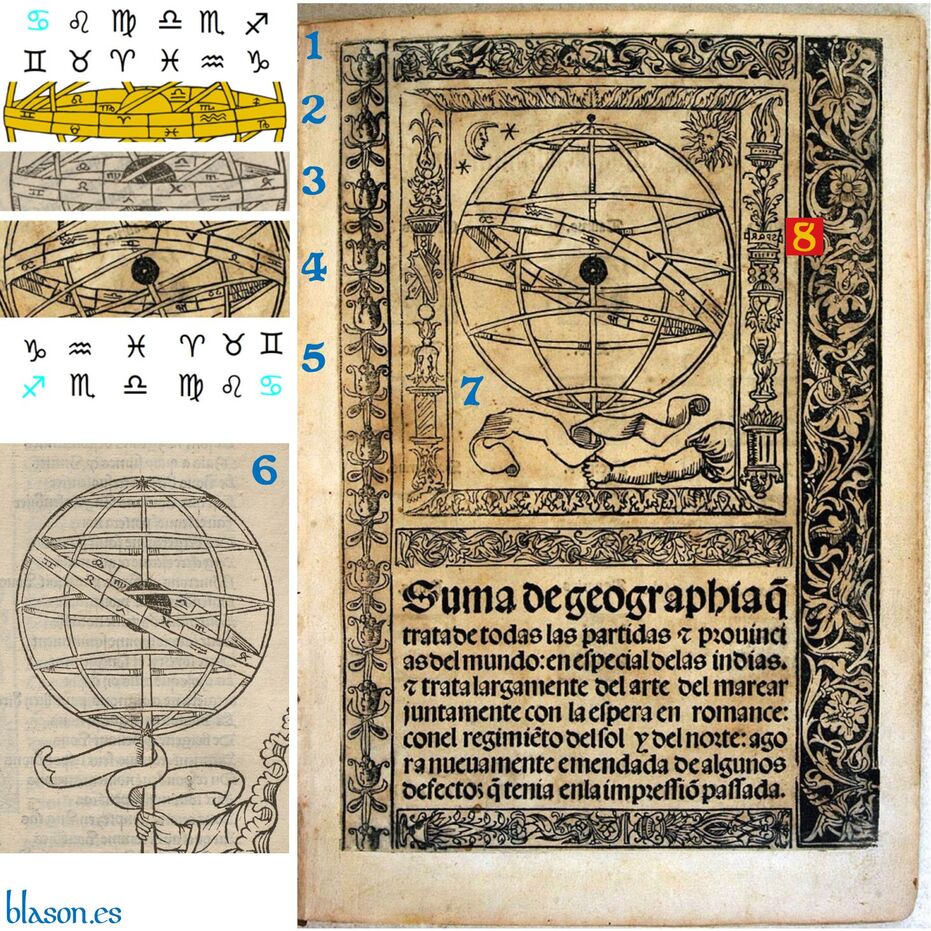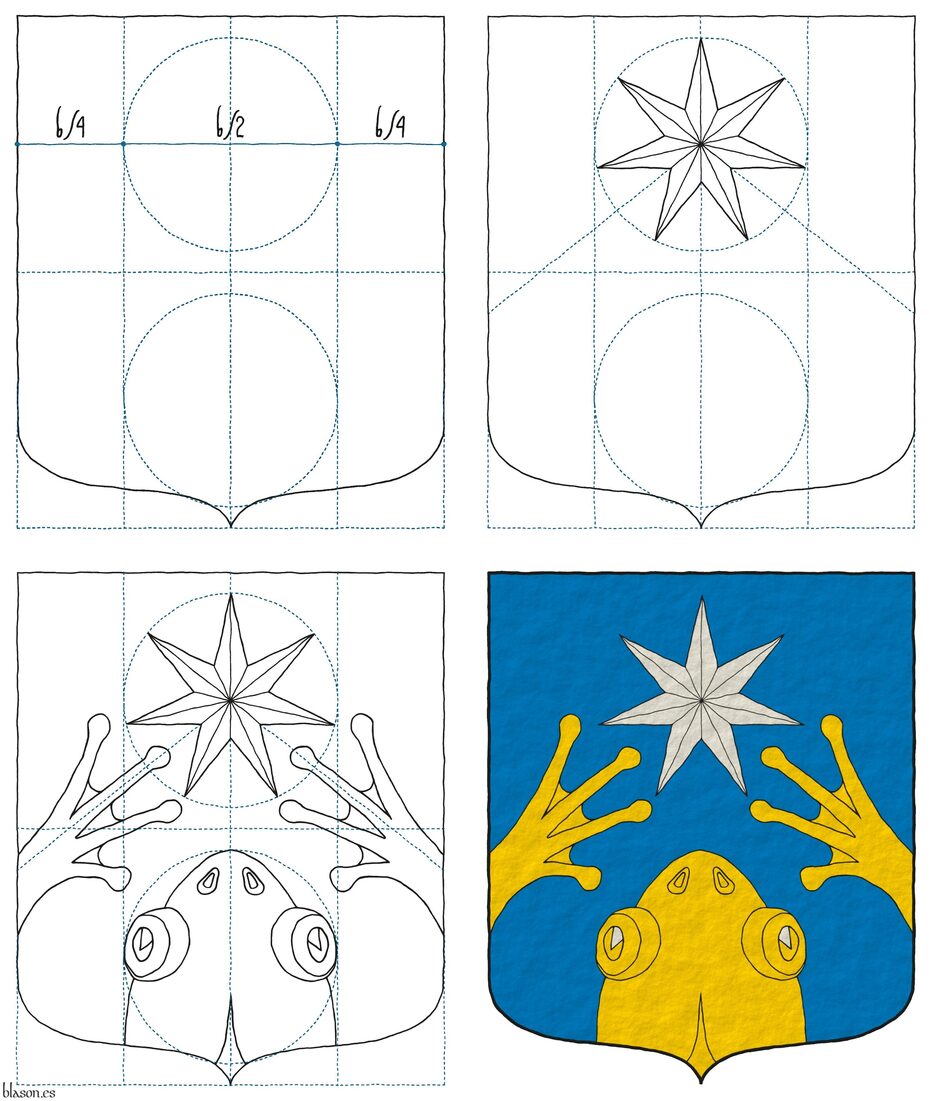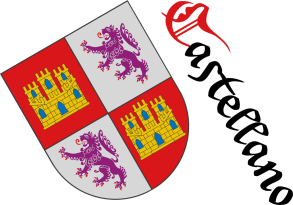
Morgan, Michael W.

Or, a griffin segreant Sable, on a chief invected Azure three naval crowns Or, the whole debruised by a label of three points Argent.
Escudo de oro, un grifo rampante de sable; en un jefe acanalado de azur, tres coronas navales de oro, brisado de un lambel de tres pendientes de plata.
Arms interpreted by me, illuminated with lights and shadows, outlined in Sable, and with a leather finish.
Coat of arms of Michael W. Morgan, UE, emblazoned by me. He is the eldest son of Commander Stephen T. Morgan and his cadency mark is a label.
Blazon keywords: Or, Sable, Gules, Azure, Argent, One, Three, Griffin, Segreant, Chief, Invected, Naval crown, Cadency and Label of three points.
Style keywords: Outlined in sable, Illuminated and Leather.
Classification: Personal, Interpreted, Boa and Coat of arms.
Bearer: Morgan, Michael W..


Lukas Podlipny, schema 1x2
Vert, a chevron Argent between three linden sprigs, three-leaved, enarched bend sinisterwise Or.
Coat of arms depicted by me, illuminated with lights and shadows, outlined in Sable, with a rounded trapezoidal outer contour and with a texturized finishing.
Coat of arms of Lukas Podlipny, Slovakia, emblazoned by me. These are canting arms, in Slovak, «lipa» ~ linden tree, and the surname Podlipný would mean «under the linden tree», «pod» ~ under, «lip-» ~ linden, hence the arched linden sprigs in the coat of arms. The image shows in 2 stages how I painted it: 1) delineation of the shield, including the calculation of a broad chevron so that the linden sprigs have enough space, since, as has been seen, they are a principal element of these canting arms, and delineation of the 3 linden sprigs, slightly different from each other to fit the shape of its space; 2) finished shield with highlights and shading.
Blazon keywords: Vert, Argent, Or, One, Three, Chevron, Between, Linden, Sprig, Leaved, Enarched and Bend sinisterwise.
Style keywords: Outlined in sable, Illuminated and Rounded trapezoid.
Classification: Personal, Interpreted, Boa and Coat of arms.
Bearer: Lukas Podlipny.


Lukas Podlipny
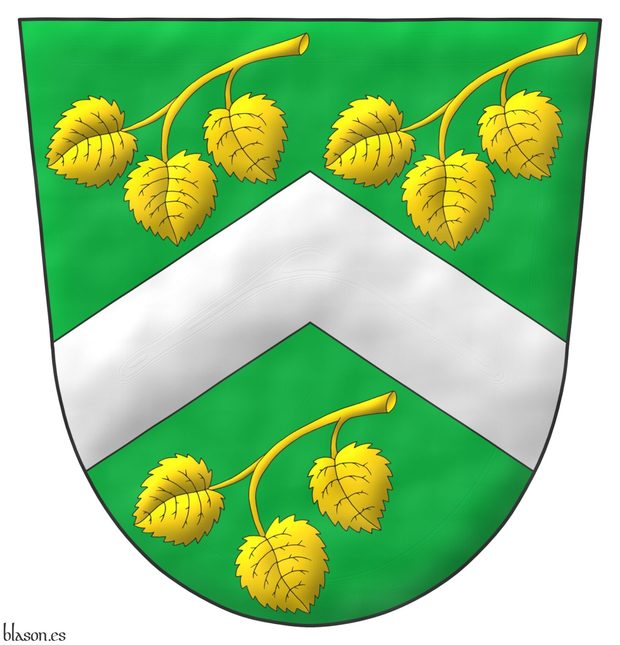
Vert, a chevron Argent between three linden sprigs, three-leaved, enarched bend sinisterwise Or.
Escudo de sinople, un chevron de plata acompañado de tres ramitas de tilo, de tres hojas, arqueadas, puestas en barra de oro.
Coat of arms painted by me, highlighted with lights and shadows, outlined in Sable, with a rounded trapezoidal outer contour and with a watercolor finishing.
Coat of arms of Lukas Podlipny, Slovakia, emblazoned by me. His name, with the diacritical marks used in Slovak, is written as Lukáš Podlipný. These are canting arms, in Slovak, «lipa» ~ linden tree, and the surname Podlipný would mean «under the linden tree», «pod» ~ under, «lip-» ~ linden, hence the arched linden sprigs in the coat of arms.
Blazon keywords: Vert, Argent, Or, One, Three, Chevron, Between, Linden, Sprig, Leaved, Enarched and Bend sinisterwise.
Style keywords: Outlined in sable, Illuminated, Rounded trapezoid and Watercolor.
Classification: Personal, Interpreted, Boa and Coat of arms.
Bearer: Lukas Podlipny.


Crest and mantling of Lukas Podlipny
Vert, a chevron Argent between three linden sprigs, three-leaved, enarched bend sinisterwise Or. Crest: Upon a tilting helm with a wreath Or and Vert, a blackbird (Turdus merula) proper, armed, membered and beaked Gules, holding in the beak over its back a linden sprig, three-leaved, enarched Or. Mantling: Vert doubled Argent.
Coat of arms painted by me, highlighted with lights and shadows, outlined in Sable, with a rounded trapezoidal external shape and with a watercolor finish.
Coat of arms of Lukas Podlipny, Slovakia, emblazoned by me. These are canting arms, in Slovak, «lipa» ~ linden tree, and the surname Podlipný would mean «under the linden tree», «pod» ~ under, «lip-» ~ linden, hence the arched linden sprigs in the coat of arms and the blackbird beneath another linden sprig.
Blazon keywords: Vert, Argent, Or, Gules, One, Three, Chevron, Between, Linden, Sprig, Leaved, Enarched, Bend sinisterwise, Crest, Upon (wreath), Tilting helm, Helm, Wreath, Mantling, Blackbird, Proper, Armed, Membered, Beaked, Grasping and Beak.
Style keywords: Outlined in sable, Illuminated, Rounded trapezoid and Watercolor.
Classification: Personal, Interpreted, Boa and Coat of arms.
Bearer: Lukas Podlipny.


Lukas Podlipny, hand-drawn
Vert, a chevron Argent between three linden sprigs, three-leaved, enarched bend sinisterwise Or.
Coat of arms of Lukas Podlipny, Slovakia. The image combines a photograph of a drawing of a linden sprig, three-leaved, enarched bend sinisterwise, along with his coat of arms, both painted by me.
Blazon keywords: Vert, Argent, Or, One, Three, Chevron, Between, Linden, Sprig, Leaved, Enarched and Bend sinisterwise.
Style keywords: Outlined in sable, Illuminated and Rounded trapezoid.
Classification: Personal, Interpreted, Boa, Hand-drawn, Collage and Photographic.
Bearer: Lukas Podlipny.


![Ver [Fernández de Enciso, M.; 1519] en referencias bibliográficas. Libro abierto, hojas de plata, filo de oro, guardas de gules, tapas de sable.](../css/Libro.Bibliografia.png)
Fernández de Enciso, M.; 1519
Martin Fernandez de Enciso, «Sum of Geography, which deals with all the parts and provinces of the world: especially the Indies. And deals extensively with the art of navigation, together with the sphere in the vernacular, with the regulation of the Sun and the North: newly made. With royal privilege.», 148 pages, House of Trade (Casa de la Contratación), Seville, 1519.
Preliminary note
Note that I try to use, even in these non-heraldic cases, the language of blazon, thus I speak of positions such as in chief, in base, dexter or sinister, arrangements such as in bend and in bend sinister and tinctures such as sable, azure or gules.
Zodiacal bands in armillary spheres: A comparative analysis of Marchant (1499) and Fernández de Enciso (1519) engravings
[Marchant, G.; 1499; page 15] and [Fernández de Enciso, M.; 1519; page 1] depict an armillary sphere with the zodiac signs, &Aries; Aries, &Taurus; Taurus, &Gemini; Gemini, &Cancer; Cancer, &Leo; Leo, &Virgo; Virgo, &Libra; Libra, &Scorpio; Scorpio, &Sagittarius; Sagittarius, &Capricorn; Capricorn, &Aquarius; Aquarius and &Pisces; Pisces, represented on a band around the sphere. I have compared both zodiacal bands by means of the composition of the previous image.
In this image I have made there are:
- In the 3rd row, the band of zodiac signs of the armillary sphere by [Marchant, G.; 1499].
- Above, in the 2nd row, the band of my interpretation of the same previous engraving.
- In chief, at the very top, in the 1st row, the zodiac signs in sable and azure, with those not visible, in the order of [Marchant, G.; 1499], that is, as read by the reader of the book, from his frontal perspective of the engraving, in counterclockwise direction, &Gemini;, &Taurus;, &Aries;, &Pisces;, &Aquarius;, &Capricorn;, &Sagittarius;, &Scorpio;, &Libra;, &Virgo;, &Leo; and &Cancer; which is not visible. Note that, for example, Taurus appears before Aries so the sequence is geocentric, that is, arranged from the point of view of an observer located at the center of the Earth, which is different from the book reader.
- Below, in the 4th row, the band of zodiac signs of the armillary sphere by [Fernández de Enciso, M.; 1519].
- In base, at the very bottom, in the 5th row, the zodiac signs in black and in cyan, with those not visible, in the order of [Fernández de Enciso, M.; 1519], that is, as read by the same reader of the book in counterclockwise direction, &Capricorn;, &Aquarius;, &Pisces;, &Aries;, &Taurus;, &Gemini;, &Cancer; which is not visible, &Leo;, &Virgo;, &Libra;, &Scorpio;, and &Sagittarius; which is also not visible. Note that in this case, for example, Aries appears before Taurus so the sequence is ecliptic, that is, from the point of view of an observer located in outer space, the point of view of the ecliptic sequence coinciding with the point of view of the book reader.
The 3 main differences observed are:
- [Marchant, G.; 1499], number 6 in the image, places at the top the zodiac signs that [Fernández de Enciso, M.; 1519], number 7 in the image, places at the bottom, as a curiosity it can be seen in my interpretation of [Marchant, G.; 1499] that for aesthetic reasons I placed at top and bottom the zodiac signs as [Fernández de Enciso, M.; 1519] does.
- They do not start in the same position, it is &Aries; Aries that has a more similar position in both but with one slot of difference.
- The signs in [Marchant, G.; 1499] and [Fernández de Enciso, M.; 1519] rotate in opposite directions.
The only important conceptual difference is the reverse rotation of the zodiac signs, that is, that [Marchant, G.; 1499] uses the geocentric sequence and [Fernández de Enciso, M.; 1519] uses the ecliptic sequence. In no case is it a printing error of an engraving in mirror, since neither of the two armillary spheres is engraved in mirror, as both have the zodiacal band in bend, and if they were engraved in mirror the zodiacal band would appear placed in bend sinister.
We could also study the few non-symmetrical signs that can be distinguished completely:
- For example, on the back side of the band of [Marchant, G.; 1499], &Scorpio; Scorpio has the scorpion’s stinger in the shape of an m pointing to sinister (the reader’s right), so it makes sense from the point of view of a geocentric observer.
- For example, on the back side of the band of [Fernández de Enciso, M.; 1519], &Leo; Leo seems to have the circle of its head to dexter (the reader’s left) and the curl of its tail to sinister (the left of a geocentric observer), while in &Scorpio; Scorpio, the stinger of the m-scorpion seems to point to dexter (the reader’s left) as if the sign were intended to be seen from the other side of the outside, piercing the band, so that the book reader sees the sign in mirror. Be that as it may, the arrangement of these 2 signs does not seem consistent with each other.
Although it is not a case of printing the engraving in mirror, such errors exist since, if we go beyond the armillary sphere of [Fernández de Enciso, M.; 1519] to study its outer decoration, we see that the SPQR, of «Senatus Populusque Romanus», is in mirror, I have marked it with a square of gules with the number 8 in the image, so that, although its armillary sphere is well printed, in the outer decoration the printer made a mistake and printed it the other way round.
Bibliographical reference of century XVI.
Classification: In black and white and Castilian language.
The author is Fernández de Enciso, Martín.
Bibliographic reference mentioned in the following articles:
External links:
Internal resources: FernandezDeEncisoM1519.SumaDeGeographia.CatedraNaval.pdf in scanned PDF format at the Naval Chair, Spanish Navy, University of Murcia..


Arturo Taborda, schema 2x2
Azure, issuant from base a frog's head and from flanks its forelegs in chevron Or, in chief a mullet of seven points Argent.
Coat of arms of Arturo Taborda, Venezuela, emblazoned by me. Four-step schema showing how I planned the construction of this coat of arms, based on two in pale, centered circles, each with a diameter equal to half the width of the shield, the first circle is used to inscribe the mullet of seven points, and the second to inscribe the frog’s head, in addition, I extended the axes of two rays of the mullet, specifically the two that form the angle of a chevron, and used those two axes as guides for placing the frog’s forelegs.
Blazon keywords: Azure, Or, Argent, One, Seven, Issuant from base, Frog, Head, Flank, Foreleg, In chevron, In chief and Mullet.
Style keywords: Ratio, Outlined, Outlined in sable, Plain tincture and Ogee.
Classification: Personal, Interpreted, Schema, Boa and Coat of arms.
Bearer: Taborda, Arturo.


Arturo Taborda, plain tincture
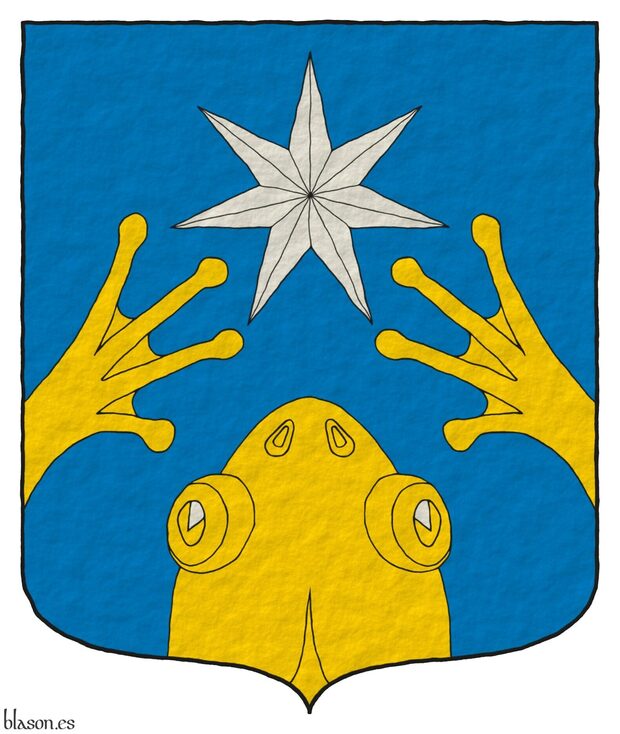
Azure, issuant from base a frog's head and from flanks its forelegs in chevron Or, in chief a mullet of seven points Argent.
Arms depicted by me, in plain tinctures, contoured in Sable, with an ogee outer contour and with a texturized finish.
Coat of arms of Arturo Taborda, Venezuela, emblazoned by me.
Blazon keywords: Azure, Or, Argent, One, Seven, Issuant from base, Frog, Head, Flank, Foreleg, In chevron, In chief and Mullet.
Style keywords: Outlined in sable, Plain tincture and Ogee.
Classification: Personal, Interpreted, Boa and Coat of arms.
Bearer: Taborda, Arturo.

Continue with: Taborda, Arturo.
-
Language
-
Categories of heraldry
-
Divisions of the field
- Without divisions
- Party per pale
- Party per fess
- Party per bend
- Party per bend sinister
- Tierce
- Tierce sinister
- Tierced per pale
- Tierced per fess
- Tierced per bend
- Tierced pallwise inverted
- Quarterly
- Quarterly per saltire
- Gyronny
- Party per fess, the chief per pale
- Party per pale, the sinister per fess
- Party per fess, the base per pale
- Party per pale, the dexter per fess
- Chapé
- Chaussé
- Embrassé
- Contre-embrassé
- Party per chevron
- Enté
- Enté en point
- Flanched
-
Metals
-
Colours
-
Furs
-
Other tinctures
-
Ordinaries and sub-ordinaries
-
Diminutives of the ordinaries
-
Other charges
-
Inanimate charges from Nature
Atom, Crescent, Diamond, Emerald, Estoile, Increscent, Lightning flash, Moon, Mount, Mullet, Mullet of four points, Orbital, Plough of Ursa Major, Rainbow, Ray of the sun, River, Sea, Snowflake, Sun, Sun in splendour, Trimount and Water.
-
Vegetal charges from Nature
Acorn, Apple, Apple tree, Ash, Bluebonnet, Camellia, Chrysanthemum, Cinquefoil, Cornflower, Dogwood flower, Double rose, Elm, Fleur de lis, Flower, Holm oak, Hop cone, Kapok tree, Laurel, Lily, Linden, Lotus flower, Madonna lily, Oak, Olive tree, Palm tree, Pomegranate, Poplar leaf, Rose, Shamrock, Sunflower, Thistle, Tree, Tulip, Vine and Wheat.
-
Animal charges from Nature
Badger, Bald eagle, Barbel, Barn owl, Bear, Beaver, Beetle, Bighorn sheep, Blackbird, Boar, Brach hound, Bull, Doe, Dog, Dolphin, Dove, Eagle, Elephant, Falcon, Fish, Flame, Fly, Fox, Frog, Goat, Goldfinch, Goose, Heron, Horse, Hummingbird, Jaguar, Lark, Leopard, Lion, Lion passant, Lion rampant guardant, Lioness, Lynx, Male figure, Martlet, Merino ram, Owl, Panther, Parrot, Peacock, Pelican, Pelican in her piety, Puffin, Quetzal, Raven, Roe deer, Rooster, Savage, Seagull, Serpent, She-wolf, Stag, Starling, Tyger, Vulture, Warren hound and Wolf.
-
Parts of natural charges
Arm, Beak, Branch, Caboshed, Chest, Claw, Covert, Dorsal fin, Eagle claw, Ermine spot, Escallop, Feather, Foot (palmiped), Foreleg, Forepaw, Hand, Head, Heart, Hoof, Leaf, Neck, Ostrich feather, Palm frond, Paw, Roe deers' attires, Shoulder, Sprig, Stags' attires, Stem, Swallow-tail, Tail, Tail addorsed, Tail fin, Talon, Tooth, Trunk, Trunk (elephant), Two hands clasped, Two wings in vol, Udder, Wheat spike, Wing and Wrist.
-
Artificial charges
Ace of spades, Anchor, Anvil, Arch, Arm vambraced, Armillary sphere, Arrow, Axe, Bell, Bell tower, Beret, Bonfire, Book, Bookmark, Bow, Bridge, Broken, Buckle, Cannon, Cannon dismounted, Cannon port, Carbuncle, Castle, Celtic Trinity knot, Chain, Chess rooks, Church, Clarion, Clay pot, Closed book, Club, Comb, Compass rose, Conductor's baton, Cord, Covered cup, Crozier, Crucible, Cuffed, Cup, Cyclamor, Dagger, Double vajra, Drum, Ecclesiastical cap, Fanon, Federschwert, Fleam, Four crescents joined millsailwise, Galician granary, Garb, Gauntlet, Geometric solid, Grenade, Halberd, Hammer, Harp, Host, Hourglass, Key, Key ward, Knight, Knot, Lantern, Letter, Line, Loincloth, Menorah, Millrind, Millstone, Millwheel, Monstrance, Mortar, Mullet of six points pierced, Nail, Non-classic artifact, Norman ship, Number, Oar, Oil lamp, Open book, Page, Pair of scales, Parchment, Pestle, Piano, Plough share, Polish winged hussar, Portcullis, Potent, Quill, Ribbon, Rosette of acanthus leaves, Sabre, Sackbut, Sail, Scroll, Scythe, Sheaf of tobacco, Ship, Skirt, Spear, Spear's head, Star of David, Sword, Symbol, Tetrahedron, Torch, Tower, Trident, Trumpet, Turret, Two-handed sword, Wagon-wheel, Water-bouget, Wheel, Winnowing fan and With a turret.
-
Immaterial charges
Angel, Archangel, Basilisk, Dragon, Dragon's head, Garuda, Golden fleece, Griffin, Heart enflamed, Mermaid, Our Lady of Mercy, Ouroboros, Paschal lamb, Pegasus, Phoenix, Sacred Heart of Jesus, Saint George, Sea-griffin, Trinity, Triton, Unicorn, Winged hand and Wyvern.
-
External elements
-
Heraldic creations
-
References
-
Formats
-
Keywords on this page
Invected, Between, Watercolor, Proper, Armed, Enarched, Azure, Bibliography, Boa, Cadency, Wreath, Head, Chevron, Upon (wreath), Crest, Collage, Ogee, Naval crown, Outlined, Outlined in sable, Hand-drawn, In black and white, In chevron, In chief, Coat of arms, Armillary sphere, Mullet, Flank, Personal, Gules, Leaved, Illuminated, Interpreted, Lukas Podlipny, Issuant from base, Or, Foreleg, Argent, Bend sinisterwise, Sprig, Frog, Seven, Vert, Taborda, Arturo, Linden, Plain tincture, Rounded trapezoid, Three and One.
